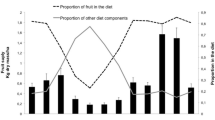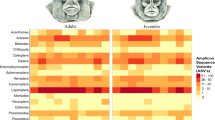Abstract
I investigated the diet and feeding ecology of two social groups of woolly monkeys (Lagothrix lagotricha poeppigii) in Yasuní National Park, Ecuador between April 1995 and March 1996. Woolly monkeys in Yasuní were predominantly frugivorous, with fruits comprising ca. 77% of the yearly diet; the next most common food type in the diet was insect and other animal prey. The fruit diet of woolly monkeys in Yasuní is the most diverse yet recorded for any ateline primate, including spider monkeys (Ateles), which are often regarded as ripe fruit specialists: ≥208 distinct morphospecies of fruits were consumed by woolly monkeys either during the study or during several preceding months of pilot work. Nonetheless, close to one-third of the yearly diet came from just 3 plant genera—Inga, Ficus, and Spondias—and only 20 genera each contributed to ≥1% of the diet. For one study group, the proportion of ripe fruit in the diet each month was correlated with the habitat-wide availability of this resource, a pattern evidenced by several other ateline species. However, the relationship was not apparent in the second study group. The modal party size for feeding bouts on all food types was a single monkey, and, contrary to reports for other atelines, neither feeding party size nor the total number of feeding minutes that groups spent in food patches was well predicted by patch size. Both results highlight the independent nature of woolly monkey foraging. Given that woolly monkeys and closely-related spider monkeys focus so heavily on ripe fruits, their very different patterns of social organization are intriguing and raise the question of just how their ecological strategies differ. Two important differences appear to be in the use of animal prey and in the phytochemical composition of the ripe fruits that they consume: spider monkeys rarely forage for animal prey, and woolly monkeys seldom consume the lipid-rich fruits that are an important part of spider monkey diets.
Similar content being viewed by others
REFERENCES
Altmann J. (1974). Observational study of behavior: Sampling methods. Behaviour 49: 227-262.
Cant, J. G. H. (1977). Ecology, Locomotion, and Social Organization of Spider Monkeys (Ateles geoffroyi), Ph.D. Dissertation, University of California, Davis.
Castellanos, H. G., and Chanin, P. (1996). Seasonal differences in food choice and patch preference of long-haired spider monkeys (Ateles belzebuth). In Norconk, M. A., Rosenberger, A. L., and Garber, P. A. (eds.), Adaptive Radiations of Neotropical Primates, Plenum, New York, pp. 451-466.
Chapman, C. (1988). Patterns of foraging and range use by three species of neotropical primates. Primates 29: 177-194.
Chapman, C. A. (1990). Ecological constraints on group size in three species of neotropical primates. Folia Primatol. 55: 1-9.
Chapman, C. A., Wrangham, R. W., and Chapman, L. J. (1995). Ecological constraints on group size: An analysis of spider monkey and chimpanzee subgroups. Beh. Ecol. Sociobiol. 36: 59-70.
Crockett, C. M., and Eisenberg, J. F. (1987). Howlers: Variations in group size and demography. In Smuts, B. B., Cheney, D. L., Seyfarth, R. M., Wrangham, R. W., and Struhsaker, T. T. (eds.), Primate Societies, University of Chicago Press, Chicago, pp. 54-68.
Defler, T. R., and Defler, S. B. (1996). Diet of a group of Lagothrix lagothricha lagothricha in Southeastern Colombia. Int. J. Primatol. 17: 161-190.
Dew, J. L. (2001). Synecology and Seed Dispersal in Woolly Monkeys (Logothrix lagotricha poppigii) and Spider Monkeys (Ateles belzehuth) in Parque Nacional Yasunı, Ecuador, Ph.D. Dissertation, University of California, Davis.
Di Fiore, A. (1997). Ecology and Behavior of Lowland Woolly Monkeys (Lagothrix lagotricha poeppigii, Atelinae) in Eastern Ecuador, PhD Dissertation, University of California, Davis.
Di Fiore, A. (2001). Investigación ecológica y de comportamiento de primates en el Parque Nacional Yasuní. In Jorgenson, J. P., and Coello Rodríguez, M. (eds.), Conservación y Desarollo Sostenible del Parque Nacional Yasuní y su Área de Influencia: Memorias del seminario-taller Yasuní, Editorial SIMBIOE, Quito, Ecuador, pp. 165-173.
Di Fiore, A., and Rodman, P. S. (2001). Time allocation patterns of lowland woolly monkeys (Lagothrix lagotricha poeppigii) in a neotropical terra firma forest. Int. J. Primatol. 22: 449-480.
Fooden, J. (1963). A revision of the wooly monkey (Genus Lagothrix). J. Mammal. 44: 213-247.
Gentry, A. H. (1993). A Field Guide to the Families and Genera of Woody Plants of Northwest South America (Colombia, Ecuador, Peru) With Supplementary Notes on Herbaceous Taxa. Conservation International, Washington, DC.
Janson, C. H., and Di Bietti, M. S. (1997). Experimental analysis of food detection in capuchin monkeys: Effects of distance, travel speed, and resource size. Beh. Ecol. Sociobiol. 41: 17-24.
Kavanaugh, M., and Dresdale, L. (1975). Observations on the woolly monkey (Lagothrix lagothricha) in Northern Columbia. Primates 16: 285-294.
Klein, L. L., and Klein, D. J. (1975). Social and ecological contrasts between four taxa of neotropical primates. In Tuttle, R. H. (ed.), Sociobiology and Psychology of Primates, Mouton, The Hague, pp. 59-85.
Leighton, M., and Leighton, D. R. (1982). The relationship of size of feeding aggregate to size of food patch: Howler monkeys (Alouatta palliata) feeding in Trichilia cipo fruit trees on Barro Colorado Island. Biotropica 14: 81-90.
Milton, K. (1980). The Foraging Strategy of Howler Monkeys: A Study in Primate Economics, Columbia University Press, New York.
Nishimura, A. (1990). A sociological and behavioral study of woolly monkeys, Lagothrix lagotricha, in the Upper Amazon. Sci. Eng. Rev. Doshisha Univ. 31: 87-121.
Peres, C. A. (1994). Diet and feeding ecology of gray woolly monkeys (Lagothrix lagotricha cana) in Central Amazonia: Comparisons with other atelines. Int. J. Primatol. 15: 333-372.
Peres, C. A. (1996). Use of space, spatial group structure, and foraging group size of gray woolly monkeys (Lagothrix lagotricha cana) at Urucu, Brazil: A review of the Atelinae. In Norconk, M. A., Rosenberger, A. L., and Garber, P. A. (eds.), Adaptive Radiations of Neotropical Primates, Plenum, New York, pp. 467-488.
Ramirez, M. (1980). Grouping patterns of the woolly monkey, Lagothrix lagothricha, at the Manu National Park, Peru. Am. J. Phys. Anthropol. 52: 269.
Ramirez, M. (1988). The woolly monkeys, genus Lagothrix. In Mittermeier, R. A., Rylands, A. B., Coimbra-Filho, A. F., and da Fonseca, G. A. B. (eds.), vol. 2, Ecology and Behavior of Neotropical Primates, World Wildlife Fund, Washington, DC, pp. 529-575.
Soini, P. (1986). A synecological study of a primate community in the Pacaya-Samiria National Reserve, Peru. Primate Conserv. 7: 63-71.
Stevenson, P. R. (1992). Diet of woolly monkeys (Lagothrix lagotricha) at La Macarena, Colombia. Field Stud. New World Monkeys, La Macarena, Colombia 6: 3-14.
Stevenson, P. R., Quiñones, M. J., and Ahumeda, J. A. (1994). Ecological strategies of woolly monkeys (Lagothrix lagotricha) at Tinigua National Park, Colombia. Am. J. Primatol. 32: 123-140.
Strier, K. B. (1986). The Behavior and Ecology of the Woolly Spider Monkey, or Muriqui (Brachyteles arachnoides E Geoffroy 1806) Ph.D. Dissertation, Harvard University.
Strier, K. B. (1989). Effects of patch size on feeding associations in muriquis (Brachyteles arachnoides). Folia Primatol. 52: 70-77.
Strier, K. B. (1990). New World primates, new frontiers: Insights from the woolly spider monkey, or muriqui (Brachyteles arachnoides). Int. J. Primatol. 11: 7-19.
Strier, K. B. (1991). Diet in one group of woolly spider monkeys, or muriquis (Brachyteles arachniodes). Am. J. Primatol. 23: 113-126.
Strier, K. B. (1992). Atelinae adaptations: Behavioral strategies and ecological constraints. Am. J. Phys. Anthropol. 88: 515-524.
Symington, M. M. (1987). Ecological and Social Correlates of Party Size in the Black Spider Monkey, Ateles paniscus chamek, Ph.D. Dissertation, Princeton University.
Symington, M. M. (1988). Food competition and foraging party size in the black spider monkey (Ateles paniscus chamek). Behaviour 105: 117-132.
Symington, M. M. (1990). Fission-fusion social organization in Ateles and Pan. Int. J. Primatol. 11: 47-61.
Terborgh, J. (1983). Five New World Primates: A Study in Comparative Ecology, Princeton University Press, Princeton, NJ.
Trivers, R. L. (1972). Parental investment and sexual selection. In Campbell, B. G. (ed.), Sexual Selection and the Descent of Man: 1871–1971, Aldine Publishing, Chicago.
van Roosmalen, M. G. M. (1985). Habitat preferences, diet, feeding strategy and social organization of the black spider monkey (Ateles paniscus paniscus Linnaeus 1758) in Surinam. Acta Amazonica 15: 1-238.
van Roosmalen, M. G. M., and Klein, L. L. (1988). The spider monkeys, genus Ateles. In Mittermeier, R. A., Rylands, A. B., Coimbra-Filho, A. F., and da Fonseca, G. A. B. (eds.), Ecology and Behavior of Neotropical Primates, vol. 2, World Wildlife Fund, Washington, DC, pp. 455-537.
Wrangham, R. W. (1980). An ecological model of female-bonded primate groups. Behaviour 75: 262-300.
Author information
Authors and Affiliations
Corresponding author
Rights and permissions
About this article
Cite this article
Fiore, A.D. Diet and Feeding Ecology of Woolly Monkeys in a Western Amazonian Rain Forest. International Journal of Primatology 25, 767–801 (2004). https://doi.org/10.1023/B:IJOP.0000029122.99458.26
Issue Date:
DOI: https://doi.org/10.1023/B:IJOP.0000029122.99458.26




